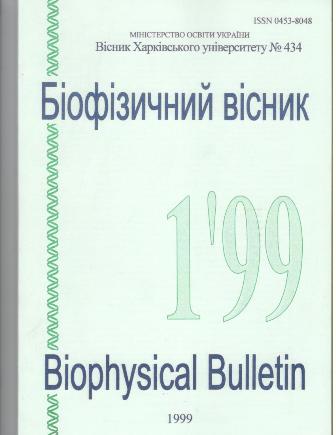QUANTUM CHEMICAL STUDY OF DECAMETHOXINUM AND RELATED DICATIONS
Анотація
The structural and electronic parameters of the dication of antimicrobial drug decamethoxinum and a set of model ammonium dications with various size of alkyl substituents at quaternary nitrogens were determined by means of AMI quantum mechanical calculations. It is shown that the most favourable conformation of the decamethoxinum dication in the absence of water solvent is an extended one with side substituents in the fraws-position with respect to the central chain and intramolecular solvation of ammonium groups by carboxyl oxygens. The positions of two centers of charge distribution in the decamethoxinum dication are close to the location of quaternary nitrogens while the analysis of the set of model dications revealed a strong dependence of the positions of such centers on type and size of the alkyl substituents. Possible correlations of the molecular parameters and the biological activity of ammonium salts are discussed.
KEY WORDS: diquaternary ammonium antimicrobial agents, decamethoxinum, quantum chemical calculations
Завантаження
Посилання
2. Волянский Ю. Л. Противомикробная активность новых азот- и фосфорсодержащих органических соединений, фенолов и ферроценов: Автореф. дисс.... д-ра мед. наук. - Москва, 1981.
3. Виевский А.Н. Механизмы биологического влияния катионных поверхностно-активных веществ. Москва. Б.И. 1990. 249 с.
4. Cooks R.G., Beynon J.H.,Caprioli R.M., Lester R.G. Metastable Ions. Elsevier. Amsterdam, 1973.
5. Szilagyi Z.,VekeyK.//Eur. Mass Spectrom. 1995. V.1. P.507-518.
6. Dewar M.J.S., Zoebisch E.G.Healy E.F.. Stewart J.J.P. // J Amer.Chem.Soc. 1985. V. 107. P.3902-3909.
7. Hull S.E., Karlsson R, Main P., Woolfson M.M. Dodson E.J. // Nature. 1978. V.275. P.206-207.
8. Gross D.S., Williams E.R. // J Am. Chem. Soc. 1995. V. 117. P.883-890
9. Szilagyi Z, Drahos L.,Vekey K. // J. Mass Spectrom. 1997. V.32. P.689-696.
10. Pashinskaya V.A., Kosevich M.V., Shelkovsky V.S., Czira G., Szilagyu Z... Vekey K. Abstr. of the 15th Inform. Meeting on Mass Spectrom., 4-6 May 1998, Budapest, Hungary. P. 86.
11. Денисенко В.П., Рудь В.П. В сб.: Физиологическая роль поверхностно-активных веществ. Черновцы. 1975. С. 40-41.
12. Гудзь О.В., Овчинников В.Г., Писько Г.Т., Смирнова НА., Тарасенко B.C. // Микробиол. журн. 1987. 49. С. 82-85.
13. Zakrzewska К., Lavery R, Pullman В. //Nucl. Acid Res. 1983. V. 11. P. 8825-8839.
Автори, які публікуються у цьому журналі, погоджуються з наступними умовами:
- Автори залишають за собою право на авторство своєї роботи та передають журналу право першої публікації цієї роботи на умовах ліцензії Creative Commons Attribution License, котра дозволяє іншим особам вільно розповсюджувати опубліковану роботу з обов'язковим посиланням на авторів оригінальної роботи та першу публікацію роботи у цьому журналі.
- Автори мають право укладати самостійні додаткові угоди щодо неексклюзивного розповсюдження роботи у тому вигляді, в якому вона була опублікована цим журналом (наприклад, розміщувати роботу в електронному сховищі установи або публікувати у складі монографії), за умови збереження посилання на першу публікацію роботи у цьому журналі.
- Політика журналу дозволяє і заохочує розміщення авторами в мережі Інтернет (наприклад, у сховищах установ або на особистих веб-сайтах) рукопису роботи, як до подання цього рукопису до редакції, так і під час його редакційного опрацювання, оскільки це сприяє виникненню продуктивної наукової дискусії та позитивно позначається на оперативності та динаміці цитування опублікованої роботи (див. The Effect of Open Access).





